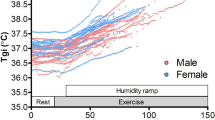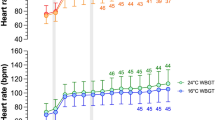Abstract
Cross-section comparisons of the effect of age on physiological responses to heat stress have yielded conflicting results, in part because of the inability to separate chronological age from factors which change in concert with the biological aging process. The present study was designed to examine the relative influence of age on cardiovascular and thermoregulatory responses to low intensity cycle exercise (60 W for 1 h) in a warm humid environment (35°C, 80% relative humidity). Specifically, the relative importance of age compared to other individual characteristics [maximal oxygen uptake (\(\dot V{\text{O}}_{\text{2}} \) max), physical activity level, anthropometry, and adiposity] was determined by multiple regression analysis in a heterogeneous sample of 56 subjects in which age (20–73 years) and\(\dot V{\text{O}}_{\text{2}} \) max (1.864–44 l · min−1) were not interrelated. Dependent variables (with ranges) included final values of thermoregulatory responses [rectal temperature (T re, 37.8–39.2°C), calculated heat storage (S, 3.4–8.1 J · g−1), sweat loss (238–847 g · m−2)] and cardiovascular responses [heart rate (HR, 94–176 beats min−1), forearm blood flow (FBF, 5.3–31.3 ml · 100 ml−1 · min−1), mean arterial blood pressure (MAP, 68–122 mmHg), and forearm vascular conductance (FVC = FBF · MAP−1, 0.06–0.44 ml · 100 ml−1 · min−1 · mmHg−1). Age had no significant influence onT re,S, or sweat loss, all of which were closely related to\(\dot V{\text{O}}_{\text{2}} \) max. On the other hand, HR, MAP, FBF, and FVC were related to both age and\(\dot V{\text{O}}_{\text{2}} \) max. Anthropometric variables and adiposity had secondary, but statistically significant, effects on MAP, FBF, FVC, and sweat loss. With respect to exercise in a warm humid environment, it was concluded that the effect of age on body temperature and sweating was negligible compared to effects related to\(\dot V{\text{O}}_{\text{2}} \) max, but that chronological age had an independent effect on cardiovascular effector responses.
Similar content being viewed by others
References
Akers RF, Buskirk ER (1969) An underwater weighing system utilizing “force cube” transducers. J Appl Physiol 26:649–652
Anderson RK, Kenney WL (1987) Effect of age on heat-activated sweat gland density and flow during exercise in dry heat. J Appl Physiol 63:1089–1094
Bovens AMPM, van Baak MA, Vrencken JGPM, Wijnen JAG, Saris WHM, Verstappen FTJ (1993) Maximal aerobic power in cycle ergometry in middle aged men and women active in sports, in relation to age and physical activity. Int J Sports Med 14:66–71
Davies CTM (1979) Thermoregulation during exercise in relation to sex and age. Eur J Appl Physiol 42:71–79
Davies CTM (1981) Thermal response to exercise in children. Ergonomics 24:55–61
Drinkwater BL, Horvath SM (1979) Heat tolerance in aging. Med Sci Sports Exerc 11:49–55
Drinkwater BL, Bedi JF, Louks AB, Roche S, Horvath SM (1982) Sweating sensitivity and capacity of women in relation to age. J Appl Physiol 53:671–676
Drinkwater BL, Kupprat IC, Denton JE, Crist JL, Horvath SM (1977) Response of prepubertal girls and college women in the heat. J Appl Physiol 43:1046–1053
DuBois D, DuBois EF (1916) Clinical calorimetry: a formula to estimate the appropriate surface area if height and weight be known. Arch Int Med 17:863–871
Fortney SM, Wenger CB, Bove JR, Nadel ER (1984) Effect of hyperosmolality on control of blood flow and sweating. J Appl Physiol Respir Environ Exerc Physiol 57:1688–1695
Gonzalez RR, Berglund LG, Stolwijk JAJ (1980) Thermoregulation in humans of different ages during thermal transients. In: Szélenyi Z, Székely M (eds). Proceedings of Satellite of 28th International Congress of Physiol. Sci. Pecs, vol 32. Pergamon Press, Oxford and Akademia Kiadó, Budapest
Havenith G, van Middendorp H (1990) The relative influence of physical fitness, acclimation state, anthropometric measures and gender on individual reactions to heat stress. Eur J Appl Physiol 61:419–427
Hellon RF, Lind AR (1958) The influence of age on peripheral vasodilation in a hot environment. J Physiol (Lond) 141:262–272
Hellon RF, Lind AR, Weiner JS (1956) The physiological reactions of men of two age groups to a hot environment. J Physiol (Lond) 133:118–131
Henane R, Flandrois R, Charbonnier JP (1977) Increases in sweating sensitivity by endurance conditioning in man. J Appl Physiol 43:822–828
Henschel A, Cole MB, Lyczkowskyj O (1968) Heat tolerance of elderly persons living in a subtropical climate. J Gerontol 23:17–22
Hodgson JL, Buskirk ER (1977) Physical fitness and age, with emphasis on cardiovascular function in the elderly. J Am Geriatr Soc 25:385–392
ISO (1993) Ergonomics of the thermal environment. Medical supervision of individuals exposed to hot or cold environments. International Organization for Standardization, Geneva, ISO CD 12894
Kenney WL (1985) A review of comparative responses of men and women to heat stress. Environ Res 37:1–11
Kenney WL (1988) Control of heat-induced vasodilation in relation to age. Eur J Appl Physiol 57:120–125
Kenney WL, Anderson RK (1988) Responses of older and younger women to exercise in dry and humid heat without fluid replacement. Med Sci Sports Exerc 20:155–160
Kenney WL, Havenith G (1993) Heat stress and age — skin blood flow and body temperature. J Thermal Biol 19:341–344
Kenney WL, Tankersley CG, Newswanger DL, Hyde DE, Puhl SM (1990) Age and hypohydration independently influence the peripheral vascular response to heat stress. J Appl Physiol 68:1902–1908
Kenney WL, Tankersley CG, Newswanger DL, Puhl SM (1991) Alpha 1 adrenergic blockade does not alter control of skin blood flow during exercise. Am J Physiol 260:H855-H861
Lind AR, Humphreys PW, Collins KJ, Foster K, Sweetland KF (1970) Influence of age and daily duration of exposure on responses of men to work in heat. J Appl Physiol 28:50–56
Nadel ER, Fortney SM, Wenger CB (1980) Effect of hydration state on circulatory and thermal regulations. J Appl Physiol Respir Environ Exerc Physiol 49:715–721
Nielsen B, Hales JRS, Strange S, Juel Christensen N, Warburg J, Saltin B (1993) Human circulatory and thermoregulatory adaptations with heat acclimation and exercise in a hot dry environment. J Physiol (Lond) 460:467–485
NIOSH (National Institute for Occupational Safety and Health) (1986) Occupational exposure to hot environments. Revised criteria. U.S. Dept. of Health and Human Services, Washington, D.C., Publication no. 86-113, 140
O'Neill PA, Faragher EB, Davies I, Wears R, McLean KA, Fairweather DS (1990) Reduced survival with increasing plasma osmolality in elderly continuing care patients. Age Ageing 19:68–71
Pandolf KB, Cadarette BS, Sawka MN, Young AJ, Francesconi RP, Gonzalez RR (1988) Thermoregulatory responses of middle-aged and young men during dry-heat acclimation. J Appl Physiol 65:65–71
Ross, AM, Jackson AS (1990) Exercise concepts, calculations and computer applications. Benchmark Press, Carmel, Ind.
Smolander J, Korhonen O, Ilmarinen R (1990) Responses of young and older men during prolonged exercise in dry and humid heat. Eur J Appl Physiol 61:413–418
Spangler PF, Risley TR, Bilyew DD (1984) The management of dehydration and incontinence in non-ambulatory geriatric patients. J Appl Behav Anal 17:397–401
Vroman NB, Buskirk ER, Hodgson JL (1983) Cardiac output and skin blood flow in lean and obese individuals during exercise in the heat. J Appl Physiol Respir Environ Exerc Physiol 55:69–74
Wagner JA, Robinson S, Tzankoff SP, Marino RP (1972) Heat tolerance and acclimatization to work in the heat in relation to age. J Appl Physiol 33:616–622
Whitney RJ (1953) The measurement of volume changes in human limbs. J Physiol (Lond) 121:1–27
Wilkinson L (1990) SYSTAT: the system for statistics. Systat, Inc., Evanston, Ill.
Yousef MK, Dill DB, Vitez TF, Hillyard SD, Goldman AS (1984) Thermoregulatory responses to desert heat: age, race and sex. J Gerontol 39:406–414
Author information
Authors and Affiliations
Rights and permissions
About this article
Cite this article
Havenith, G., Inoue, Y., Luttikholt, V. et al. Age predicts cardiovascular, but not thermoregulatory, responses to humid heat stress. Europ. J. Appl. Physiol. 70, 88–96 (1995). https://doi.org/10.1007/BF00601814
Accepted:
Issue Date:
DOI: https://doi.org/10.1007/BF00601814




